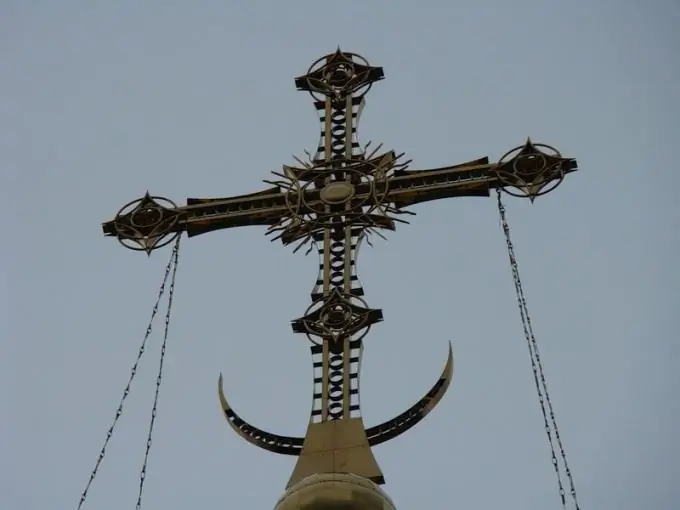- Author Antonio Harrison [email protected].
- Public 2023-12-16 07:44.
- Last modified 2025-01-22 21:44.
Many Orthodox churches have a crescent at the base of the cross. This is perceived by many as a symbol of triumph over Islam. Some, on the contrary, argue, especially seeing such a symbol on new temples, that this signifies the unification of all religions. Both assumptions are far from the truth.

The combination of a cross and a crescent moon was used by Christians even before the emergence of Islam, so this crescent moon has nothing to do with the Muslim religion. The crescent-shaped symbol called tsata came from Byzantium.
Constantinople crescent
The city of Byzantium, later called Constantinople, acquired a symbol in the form of a crescent long before the emergence of not only Islam, but also Christianity. It was the sign of Hecate, the goddess of the moon. The inhabitants and rulers of the city really had a serious reason to feel gratitude both to the moon and to her goddess, because it was the night luminary that the city owed its salvation.
Everyone knows the campaigns of conquest by Alexander the Great, but the father of this king, Philip II, was also a conqueror. In 340 BC. he intended to capture Byzantium. The king calculated everything exactly: his army was supposed to approach the city under cover of night and attack it unexpectedly, this would give the Macedonians an advantage.
Only one moment was not taken into account by the experienced commander: that night the moon was shining brightly over Byzantium. Thanks to its light, the Byzantines noticed the approach of the Macedonian army in time and prepared to repel the attack. Philip II failed to capture the city.
Since then, the rulers of the city have worn the image of the crescent - tsatu - as a sign of power. This custom was inherited by the Byzantine emperors when Byzantium - then already Constantinople - became the capital of the Eastern Roman Empire. So tsata became a symbol of imperial power.
Crescent moon as a Christian symbol
The custom was not lost in Christian times, but it was filled with new meaning. Byzantium inherited from Rome the idea of the emperor's divinity. In Christianity, this idea was refracted in its own way, in the form of an idea of the divine origin of the imperial power. On the other hand, the Savior himself appeared to be the King, to whom, according to the Holy Scriptures, "was given … all authority in Heaven and on Earth." So tsata - a symbol of imperial power - became associated with the power of God.
Tsata evokes other associations among Christians. In particular, in the “Revelation of John the Theologian,” the Mother of God appears in the form of a woman wearing a crown of 12 stars, with a month at her feet. The overturned crescent moon resembles a chalice, thereby associating with the sacred chalice of the sacrament of the Eucharist.
Thus, the crescent, located at the base of the cross on the domes of Orthodox churches, has a lot of meanings.






